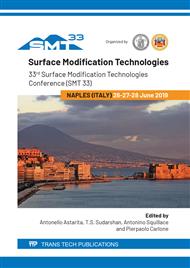[1]
G. Lutjering, J.C. Williams, Titanium, Springer-Verlag, Berlin-Heidelberg-New York, (2007).
Google Scholar
[2]
K. Niespodziana, K. Jurczyk, M. Jurczyk, The synthesis of titanium alloys for biomedical applications, Rev. Adv. Mater. Sci. 18 (2008) 236-240.
Google Scholar
[3]
I. Cvijovic-Alagic, Z. Cvijovic, S. Mitrovic, V. Panic, M. Rakin, Wear and corrosion behariour of Ti-13Nb-13Zr and Ti-6Al-4V alloys in simulated physiological solution, Corros. Sci. 53 (2011) 796-808.
DOI: 10.1016/j.corsci.2010.11.014
Google Scholar
[4]
L. le Guehennec, A. Soueidan, P. Layrolle, Y. Amouriq, Surface treatments of titanium dental implants for rapid osseointegration, Dental materials 23 (2007) 844-854.
DOI: 10.1016/j.dental.2006.06.025
Google Scholar
[5]
X. Liu, P.K. Chu, C. Ding, Surface modification of titanium, titanium alloys, and related materials for biomedical applications, Mater. Sci. Eng. R 47 (2004) 49-121.
DOI: 10.1016/j.mser.2004.11.001
Google Scholar
[6]
E. Lukina, A. Laka, M. Kollerov, M. Sampiev, P. Mason, P. Wagstaff, H. Noordeen, W.W. Yoon, G. Blunn, Metal concentrations in the blood and tissues after implantation of titanium growth guidance sliding instrumentation, Spine J. 16 (2016) 380-388.
DOI: 10.1016/j.spinee.2015.11.040
Google Scholar
[7]
A. Zhecheva, W. Sha, S. Malinov, A. Long, Enhancing the microstructure and properties of titanium alloys through nitriding and other surface engineering methods, Surf. Coat. Technol. 200 (2005) 2192-2207.
DOI: 10.1016/j.surfcoat.2004.07.115
Google Scholar
[8]
M.A. Khan, R.L. Williams, D.F. Williams, In vitro corrosion and wear of titanium alloys in the biological environment, Biomaterials 17 (1996) 2117-2126.
DOI: 10.1016/0142-9612(96)00029-4
Google Scholar
[9]
T.I. Kim, J.H. Han, I.S. Lee, K.H. Lee, M.C. Shin, B.B. Choi, New titanium alloys for biomaterials: a study of mechanical and corrosion properties and cytotoxicity, Biomed. Mater. Eng. 7 (4) (1997) 253-263.
DOI: 10.3233/bme-1997-7404
Google Scholar
[10]
E. Galvanetto, F.P. Galliano, A. Fossati, F. Borgioli, Corrosion resistance properties of plasma nitrided Ti-6Al-4V alloy in hydrochloric acid solutions, Corros. Sci. 44 (2002) 1593-1606.
DOI: 10.1016/s0010-938x(01)00157-3
Google Scholar
[11]
V. M. Fedirko, I. M. Pohrelyuk, Nitriding of titanium and its alloys, Кyiv Press, (1995).
Google Scholar
[12]
V.A. Alves, R.Q. Reis , I.C.B. Santos, D.G. Souza, T. de F. Gonçalves, M.A. Pereira da Silva, A. Rossi, L.A. da Silva, In situ impedance spectroscopy study of the electrochemical corrosion of Ti and Ti–6Al–4V in simulated body fluid at 25 oC and 37 oC, Corros. Sci. 51 (2009) 2473-2482.
DOI: 10.1016/j.corsci.2009.06.035
Google Scholar
[13]
M.A. Arenas, T.J. Tate, A. Conde, J. de Damborenea, Corrosion behaviour of nitrogen implanted titanium in simulated body fluid, Br. Corros. J. 35 (2000) 1-5.
DOI: 10.1179/000705900101501308
Google Scholar
[14]
V.V. Shyrokov, L.A. Arendar, Yu.I. Koval'chyk, Kh.B. Vasyliv, O.M. Vasyliv, Computer processing of profilograms of friction surfaces, Mater. Sci. 41 (2005) 107-112.
DOI: 10.1007/s11003-005-0138-2
Google Scholar
[15]
S. Bose, L.C. Pathak, R. Singh, Response of boride coating on the Ti-6Al-4V alloy to corrosion and fretting corrosion behavior in Ringer's solution for bio-implant application, Appl. Surf. Sci. 433 (2018) 1158-1174.
DOI: 10.1016/j.apsusc.2017.09.223
Google Scholar



